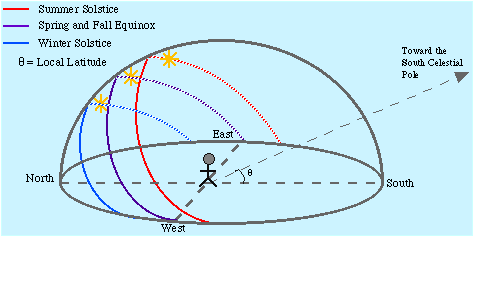

You might wonder why this is important for building sundials. The Sun is also a star, so the Sun also rotates around the South Celestial Pole. It is this rotation that will allow us to use the Sun to tell time.
We need to know where the South Celestial Pole is to use our sundials. How can we find this special place in the southern sky?
No matter where you live in the Southern Hemisphere there is an easy way to find the South Celestial Pole. As you might have guessed it is located due south, but how high in the sky is it? The South Celestial Pole is up from the horizon exactly an angle equal to your latitude. So if you live at 50 degrees latitude, the South Celestial Pole will be due south, up 50 degrees.
(An average person has about 10 degrees, from little finger to folded thumb, in a closed fist when held an arm's length away.)
The arrow you see pointing toward the South Celestial Pole in the diagram above is infact the axis about which the Sun, and all other stars rotate. All we need to do to make a well designed horizontal sundial tell time is to point the gnomon of the sundial along this axis. Then, as the Sun rotates around the gnomon it will cast a shadow onto our sundial surface where we will mark the appropriate hourlines. Both the angle of the gnomon and the position of the hourlines depend on the latitude where the sundial will be used.
Now let's find out how to locate geographic
south.
![]()
![]()

![]()